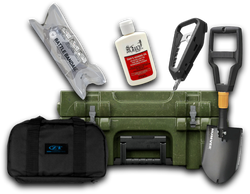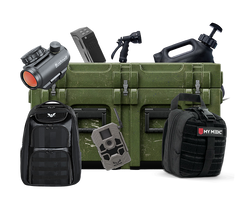Understanding the Size and Impact of Musket Balls: How Big Is a Musket Ball?
Table of Contents
- Introduction
- The Basics of Musket Balls
- Historical Context of Musket Balls
- The Transition to Advanced Ammunition
- Conclusion
- FAQ
Introduction
Imagine standing on a battlefield in the 18th century, the air thick with smoke and the sound of gunfire ringing in your ears. In this chaotic environment, soldiers wield a weapon that has shaped the course of history—the musket. But how significant are the components of this weapon, particularly its ammunition? More specifically, how big is a musket ball?
Musket balls, the spherical projectiles used in muskets, played a pivotal role in warfare from the 16th to the 19th centuries, altering combat strategies and the very fabric of society. These lead spheres varied considerably in size, typically measured in calibers, a unit that denotes the diameter of the projectile. The most common calibers ranged from .54 to .80 inches, with the British “Brown Bess” musket using a .75 caliber ball. Understanding these sizes is not merely an exercise in curiosity; it sheds light on the lethality of firearms during this period and their historical significance.
In this blog post, we will explore the dimensions of musket balls, the historical context of their use, and the evolution of ammunition technology. By the end of this article, you will have a comprehensive understanding of musket ball sizes, their impact on military strategy, and the transition from musket balls to more advanced ammunition types, such as the Minié ball.
The Basics of Musket Balls
What Is a Musket Ball?
A musket ball is a solid spherical projectile made primarily of lead, designed for use in smoothbore muskets. Unlike modern bullets, which are often conical and aerodynamically shaped, musket balls are round and typically measure between .54 to .80 inches in diameter. The size and weight of these balls were critical factors that influenced their ballistic performance and effectiveness in combat.
Common Sizes of Musket Balls
To understand how big a musket ball is, it’s essential to look at the common calibers used throughout history:
- .54 Caliber: This was prevalent in various European and American muskets, often used in the Civil War.
- .58 Caliber: Often associated with the Springfield Model 1861, a significant rifle musket during the American Civil War.
- .69 Caliber: The standard size for British muskets, particularly the “Brown Bess,” widely used in the 18th and early 19th centuries.
- .75 Caliber: This was a common size for many British military muskets.
- .80 Caliber: Used in some larger military muskets, particularly in the German states.
The choice of caliber depended on several factors, including the intended use of the musket, the type of warfare, and the design of the firearm itself.
The Weight of Musket Balls
The weight of a musket ball is directly correlated to its size, affecting its kinetic energy and potential damage upon impact. For example, a .69 caliber musket ball typically weighs around 480 grains, while a .75 caliber ball can weigh about 550 grains.
The relationship between size, weight, and kinetic energy is crucial. A heavier ball carries more energy, translating into greater damage upon impact, especially against unarmored or lightly armored targets. However, it also needs to fit well within the musket’s barrel to ensure proper firing—too tight, and it could jam; too loose, and it would not achieve the desired accuracy.
Historical Context of Musket Balls
The Evolution of Muskets
Muskets first appeared in the early 16th century, evolving from earlier firearms like the arquebus. Initially, muskets were heavy, cumbersome weapons with smoothbore barrels. The transition to rifled barrels, which allowed for greater accuracy and range, began in the 19th century. However, early muskets relied on the round musket ball, a design that would dominate for centuries.
The Use of Musket Balls in Warfare
Musket balls were integral to military tactics during their era. The smoothbore design of muskets meant that accuracy was often sacrificed for rapid fire. Soldiers would load their muskets with a pre-measured charge of gunpowder followed by a musket ball, often wrapped in cloth or paper to create a snug fit. This method allowed troops to fire in volleys, a tactic that would prove devastating on the battlefield.
The lethality and widespread use of musket balls contributed to significant shifts in military engagements. The transition from hand-to-hand combat to ranged engagements marked a pivotal change in warfare, demanding new tactics and formations.
Impact on Soldier and Civilian Life
The presence of musket balls on the battlefield had far-reaching effects, not only on soldiers but also on civilian populations. The injuries caused by musket balls were often gruesome due to the soft lead material, which would deform upon impact, creating large wounds that were prone to infection. This was particularly troubling in an era before antibiotics, causing many injuries to become fatal.
Moreover, the production of musket balls became a significant part of the wartime economy. Armories and workshops sprang up to meet the demand for lead projectiles, and civilians often played a role in manufacturing ammunition during wartime.
The Transition to Advanced Ammunition
The Minié Ball
With advancements in firearm technology, the musket ball eventually gave way to more sophisticated ammunition types, such as the Minié ball, developed in the 1840s. This conical bullet featured a hollow base, which allowed it to expand upon firing and grip the rifling of the barrel, leading to increased accuracy and range. The Minié ball represented a significant leap in ballistic technology, as it could be loaded quickly and fired with remarkable precision.
The Impact of Rifling on Ammunition Design
As muskets transitioned from smoothbore to rifled designs, the dimensions of ammunition changed. The rifled musket could accommodate elongated projectiles, which were more aerodynamically efficient than traditional musket balls. This shift not only improved accuracy but also allowed for longer engagement ranges, fundamentally altering military tactics.
Conclusion
Understanding how big a musket ball is involves more than just knowing its diameter; it requires an appreciation of the historical and technological context that shaped its use in warfare. Musket balls, with their varying sizes and weights, played a crucial role in military history, influencing tactics and the outcomes of battles.
As we reflect on the evolution from the musket ball to more advanced ammunition like the Minié ball, we see a clear trajectory of innovation in firearms technology. This advancement has not only enhanced military effectiveness but has also paved the way for modern firearms.
In conclusion, whether you’re a history enthusiast, a firearms aficionado, or simply curious about the impact of these historical projectiles, understanding the size and significance of musket balls offers valuable insight into the past and the evolution of warfare.
FAQ
What is the average size of a musket ball?
The average size of a musket ball typically ranges from .54 to .80 inches in diameter, with the most common size being .69 inches, especially in the British “Brown Bess” musket.
Why were musket balls made of lead?
Musket balls were made of lead due to its malleability and ability to deform upon impact, which could create larger wounds and increase lethality in combat.
How did musket balls affect military tactics?
Musket balls allowed for rapid volleys of fire, transforming battlefield tactics from close combat to ranged engagements, necessitating new formations and strategies.
What replaced musket balls in firearms?
Musket balls were replaced by more advanced ammunition types, such as the Minié ball, which had a conical shape and could be used in rifled barrels, providing better accuracy and range.
Are there any modern equivalents to musket balls?
While modern ammunition has evolved significantly, the concept of a projectile designed for a firearm remains the same. However, contemporary bullets are designed for maximum efficiency, accuracy, and lethality, often taking shapes that are vastly different from the traditional musket ball.
For those interested in tactical gear and survival tools related to historical contexts, check out Crate Club’s subscription services for curated gear that emphasizes preparedness and quality. Explore the Crate Club Shop for a range of tactical equipment designed for today’s survivalists and outdoor enthusiasts.
- Explore Crate Club’s subscription services: Crate Club Subscription
- Visit the Crate Club Shop: Crate Club Shop
Comparte este artículo



